The condition of your kitchen cabinets plays a vital role in the functionality and aesthetics. Well-maintained cabinets enhance the look of your space and provide practical storage solutions to keep everything organized.
However, cabinetry problems can arise over time due to wear and tear, climate changes, or other environmental factors. Here’s a detailed look at the most common issues with kitchen cabinetry and how to address them effectively.
Water Damage
Water is one of the biggest culprits when it comes to damaged kitchen cabinets. Leaks from sinks, spills, or excessive humidity can result in swollen wood, peeling finishes, or even mold growth. It’s crucial to prevent and repair water damage as soon as you spot the signs, such as swollen cabinet doors or discoloration.
To protect your cabinets from future water damage, regularly check for leaks in plumbing and wipe up spills immediately. Adding a water-resistant sealant to exposed wood areas can also provide extra protection. Severe cases may require full cabinet replacement.
Warping and Cracking
Sudden or frequent changes in temperature and humidity can cause cabinetry materials to expand and shrink. Over time, this movement leads to warping or cracking, especially in natural wood cabinets. Warped cabinet doors are unattractive and prevent proper closure, while cracks can weaken their structural integrity.
To avoid this issue, maintain a consistent environment in your kitchen by using air conditioning or a dehumidifier during extreme weather. When choosing new cabinets, pick materials that offer durability and resist warping, such as plywood backed with MDF (medium-density fiberboard). If you notice warped sections, removing and replacing them is often the best solution.
Hardware Problems
Loose or malfunctioning hardware is a common frustration for homeowners. Hinges can gradually loosen, handles may wiggle, and drawer slides may no longer function as expected. These issues reduce the functionality of your cabinets and create an unkempt appearance.
To keep hardware in good condition, tighten screws regularly before they become loose. Lubricate drawer slides as needed to ensure smooth operation. If the hardware is damaged, consider upgrading to higher-quality options. This could include soft-close hinges or modern handles that improve the cabinetry’s safety and aesthetic appeal.
Fading or Peeling Paint
Over time, the paint on kitchen cabinets can fade due to exposure to sunlight or peel from excessive moisture and general wear. Faded or peeling paint makes your cabinets look dated and poorly maintained.
To handle these issues effectively, paint your kitchen cabinets like a pro by using high-quality paint and a proper primer. Start by thoroughly cleaning and sanding the surfaces to remove old paint or finishes. Then, apply a durable primer that suits the base material and protects against moisture. Finally, use a topcoat designed for high-traffic, high-humidity areas like kitchens.
Kitchen cabinets are a long-term investment, and with the right measures, you can extend their useful life while keeping them in pristine condition. By addressing common issues—be it water damage, warping, hardware troubles, or worn paint—you’ll maintain both the beauty and functionality of your kitchen cabinetry.

